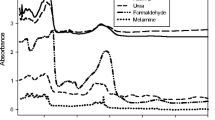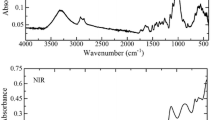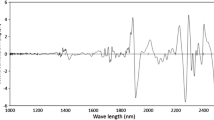Abstract
Melamine-urea-formaldehyde resin production has increased in the last years due to low formaldehyde emissions and improved moisture resistance when applied on wood-based panels. Melamine is a relatively high-cost raw material in the resin formulation and has a significant effect on wood-based panel properties. It is important for industry to implement efficient quality control methods to determine melamine content in resins. The main objective of this work was to develop chemometric techniques for off-line monitoring of melamine content using near-infrared spectroscopy. The use of interval partial least squares regression allowed identifying the most interesting spectral ranges for analysis (4,400–4,800 and 5,200–5,600 cm−1) and the best preprocessing methods to use in the determination of this property. When the appropriate spectral range and preprocessing methods are selected, it is possible to obtain calibration models with high correlation coefficients.
Similar content being viewed by others
Avoid common mistakes on your manuscript.
Introduction
Amino resins are the most used binders in wood-based panels industry. In this group of adhesives, one can consider urea-formaldehyde (UF), melamine-formaldehyde (MF) and melamine-urea-formaldehyde resins (MUF) (Pizzi 2003). UF resins represent 80 % of the amino resins produced worldwide (Conner 1999), while the remainder are mostly MUF (Pizzi 2003). One can distinguish between two types of melamine containing resins: MUF resins, where the melamine content is above 5 %, and melamine-fortified UF resins with a melamine content below 5 % (Paiva et al. 2012; Young No and Kim 2007).
MUFs have a manufacturing process very similar to UF. Since they exhibit lower formaldehyde emissions and improved physical properties on wood panels (mostly moisture resistance) its production has been increasing steadily. However, due to the high costs of melamine, MF resins still have limited use.
It is therefore relevant to develop quality control methods for determining the melamine content in the final product. Some methodologies have been reported in the literature. Widmer (1956) did a quantitative determination of melamine in MF condensation products. In this method, the resins are destroyed under pressure by aminolysis leaving the melamine intact. Hirt et al. (1954) published a method for the detection of melamine by ultraviolet spectrophotometry, in which the resin is extracted from comminuted MF samples using hydrochloric acid (Pizzi 2003).
Being relevant in food industry, many melamine determination methods have been developed, as described by Mauer et al. (2009). However, several of these have laborious sample preparation and cleanup procedures and are time-consuming.
Near-infrared spectroscopy (NIRS) combined with chemometrics (e.g., data-based modeling techniques) might offer a number of advantages for qualitative and quantitative analysis of melamine content in quality and process control applications, such as no need for sample preparation, no waste production, reduced costs, fast measurements (Henriques et al. 2012; Mauer et al. 2009). The application of this technique in food industry to determine the amount of melamine has been described in several papers, such as Lu et al. (2009) and Mauer et al. (2009), in both cases showing to be a rapid, non-destructive and inexpensive analysis technique (Mauer et al. 2009; Lu et al. 2009).
NIR analysis usually involves the rapid acquisition of a large number of absorbance values. The spectral information is then used to predict the composition of the sample by extracting the variables of interest. Generally, NIR spectroscopy is used in combination with multivariate techniques, like partial least squares (PLS), target transformation factor analysis (TTFA) and curve resolution (MCR) for qualitative or quantitative analysis (Xiaobo et al. 2010).
To improve the capabilities of PLS modeling, a technique called iPLS (interval partial least squares regression) has been used, in which data are subdivided into non-overlapping sections that each undergo separate PLS processing to determine the most useful variable range (Xiaobo et al. 2010).
Interval PLS models are developed on spectral subintervals of equal width. The purpose is to find the intervals that give better predictions. The comparison is mainly based on the validation parameter root-mean-squared error of cross-validation (RMSECV), but other parameters such as correlation between measured and predicted values, and PLS factors are also evaluated (Andersen and Bro 2010).
To optimize the PLS models, both cross-validation or external validation can be used. Spectrum quality can be affected by several factors, so it is necessary to select the preprocessing method judiciously in order to minimize the influence of adverse effects (Büning-Pfaue 2003; Pizarro et al. 2004).
The aim of this work is therefore to (1) use iPLS to ascertain the spectra wavenumber range(s) that provide better predictions and (2) determine the feasibility of FT-NIR spectroscopy for estimating the melamine content in MUF resins.
Materials and methods
Laboratory resin synthesis
All resins were produced in a 2.5 L round bottom flask equipped with thermometer, mechanical stirrer and condenser. The temperature was controlled manually using a heating mantle. The pH was measured off-line using a pH meter. The resins were produced according to the single-stage process described in literature (Kamoun and Pizzi 2000; Hse et al. 2008; Tohmura et al. 2001).
Solid urea is added at constant flow rate to an alkaline environment formaldehyde solution at 8–9 pH by addition of sodium hydroxide solution 50 %, promoting a methylolation reaction.
To initiate the reaction, the mixture was heated and maintained at 80–90 °C (depending on the resins synthesized) to promote the formation of UF prepolymer. At 30 min reaction time, melamine was added (16, 14 and 10 %) and reaction progressed until a viscosity of about 500 cP is attained.
In the third stage, the pH was adjusted to a slightly basic value by adding sodium hydroxide solution. The final amount of urea added should be sufficient for the formaldehyde/urea molar ratio to reach values of 2.0–1.5 at the end of this step.
In order to obtain samples with different melamine content, the resins were divided into several portions, to which different amounts of urea were added. Melamine contents were obtained within the ranges 16–13 and 10–9 wt% (relative to total resin mass).
A total of 216 laboratory-synthesized resin samples were used for calibration. One hundred and sixty-two laboratory-synthesized resins were used for test validation. Seventeen industrial resins supplied by EuroResinas were also used in a separate validation analysis.
FT-NIR analysis
NIR spectra were acquired as described in Henriques et al. (2012). The transmission probe had an optical sapphire window, 1 mm path length and 600 μm diameter. The probe was connected, via optical fiber, to a Bruker (www.bruker.de) Zaffiro FT-NIR process-spectrometer with a TE-InGaAs detector and a spectral range between 12,000 and 4,000 cm−1. Spectra for each resin were collected with a spectral resolution of 8 cm−1 in triplicate at a zero filling factor of 2 each representing an average of 32 scans. A reference spectrum was previously collected in air to account for possible impurities present in the probe surface. The probe was carefully washed prior to switching to a different resin. The resins were stored at 25 °C before spectra collection, which took place 1 day after the synthesis.
Chemometrics
The spectral manipulations were performed using OPUS Quant 2 software package by Bruker.
In order to determine the most useful spectral regions, calibrations were developed using iPLS with 20 intervals. The error estimation parameter adopted was the root-mean-square error of cross-validation (RMSECV) (Andersen and Bro 2010).
In RMSECV, \( y_{i} \) is the actual value of melamine content (wt%), \( \hat{y}_{i} \) is the PLS predicted value and n is the total number of test samples (Li et al. 2006).
After the spectral region selection, model calibration and validation was performed. External validation was used, since this leads to a more robust method when a sufficiently high number of samples are available (Naes et al. 2002). This implied using a set of samples independent from those used in calibration, but prepared under identical conditions. To assess the quality of the model, the standard error of prediction (RMSEP) and the standard error of calibration (RMSEE) were adopted as error estimation parameters for both calibration and validation procedures (Ham et al. 1994).
In RMSEP, \( m_{i} \) is the reference value of melamine content, \( \hat{m}_{i} \) is the PLS predicted value and \( n_{m} \) is the total number of test samples. In RMSEE, \( t_{i} \) is the reference molar ratio F/U, \( \hat{t}_{i} \) is the predicted PLS value, \( {\text{n}}_{\text{t}} \) is the total number of validation samples and h the number of PLS factors (ranging from 1 to 10).
The best number of factors is found when the lowest value of mean square error of cross-validation is obtained (Conzen 2006).
The R 2cal and R 2val correlation values were used to quantify the predictability of each method (Büning-Pfaue 2003). The general goal was to obtain low values of RMSEE and RMSEP and high values of R 2cal and R 2val .
Results and discussion
Characterization of FT-NIR spectrum
Figure 1 shows an iPLS model with 20 intervals and the predictions obtained for each interval. As expected, the RMSECVs values are higher in the range closer to the visible spectrum (Andersen and Bro 2010). Figure 1 indicates that the lowest RMSECV values are obtained for wavenumbers between 4,400 and 4,800 cm−1 (darker gray bar in the Figure).
In order to increase the amount of information available to the model, an additional test was performed, combining the previously selected interval (4,400–4,800 cm−1) with each of the other remaining intervals. The results are shown in Fig. 2. The model that combines the intervals 4,400–4,800 and 5,200–5,600 cm−1 (darker gray bar in Fig. 2) gave a RMSECV value slightly lower than the one obtained before considering only the 4,400–4,800 cm−1 interval.
The wavenumber intervals identified as yielding lower RMSECVs values are identical to those described in the literature for detection of melamine in infant formula, milk powder and resins (Mauer et al. 2009; Lu et al. 2009; Kasprzyk and Proszyk 2001).
The selected regions exclude the peaks associated with the presence of water (8,600, 5,200, 11,800, 5,620, 5,150, 6,900 and 4,115 cm−1), which usually introduces noise, and therefore influences negatively the regression models (Henriques et al. 2012).
After this step, various spectral preprocessing methods were applied to laboratory-synthesized resins (study I) and industrial resins (study II). The results were compared and the best methods selected.
A statistical summary is given in Table 1 for study I. Comparing the results of all preprocessing methods, the use of the first derivative with vector normalization (SNV), first derivative and first derivative with vector normalization provided the best results yielding the lowest values of RMSEE and RMSEP and the highest values of R 2cal and R 2val .
In order to determine the best of the three approaches, Fig. 3a shows RMSEP plotted as a function of PLS factors for this study. The lowest RMSEP is obtained using vector normalization with 6 factors and first derivative with vector normalization with 8 factors. The vector normalization with 6 factors was adopted here, because the optimal number of PLS factor was determined by the location of this inflection point (Bjørsvik and Martens 2008). According to Chen et al. (2006), the normalization vector preprocessing method removes slope variation and corrects scattering effects.
For the industrial resins (Table 2), the preprocessing methods that provide the best results are the same as above. The model that uses vector normalization with 7 PLS factors is the best model (Fig. 3b).
In order to verify the potential of NIR technology and the applicability of the developed method, this was applied to resins with known melamine content. The results were compared to those obtained with the reference method used in industry based on the spectrophotometry procedure developed by Hirt et al. (1954) (Pizzi 2003).
According to the results in Table 3, the NIR-based method provides better predictions of the melamine content than the more complex and time-consuming reference method.
Conclusion
For analysis of melamine content in amino resins, spectral regions 4,400–4,800 and 5,200–5,600 cm−1 were identified by iPLS as providing the best results, in agreement with the spectral regions described in literature as being associated with this property. Calibration models were developed taking into account these regions for a set of laboratory-synthesized and industrial resins, and different preprocessing methods were evaluated. The best approaches were identified based on the correlation values obtained. Vector normalization preprocessing gave the best results.
The performance of the NIR method developed was compared to the spectrometric reference method used in industry for two industrial productions. The NIR method provided better predictions of melamine content. In addition, it is a much faster and straightforward method.
References
Andersen CM, Bro R (2010) Variable selection in regression—a tutorial. J Chemom 24(11–12):728–737
Bjørsvik H-R, Martens H (2008) Data analysis: calibration of NIR instruments by PLS regression. In: Burns D, Ciurczak E (eds) Hnadbook of near infrared analysis. CRC Press, Boca Raton, FL, pp 189–205
Büning-Pfaue H (2003) Analysis of water in food by near infrared spectroscopy. Food Chem 82(1):107–115
Chen Q, Zhao J, Zhang H, Wang X (2006) Feasibility study on qualitative and quantitative analysis in tea by near infrared spectroscopy with multivariate calibration. Anal Chim Acta 572(1):77–84
Conner AH (1999) Urea-formaldehyde adhesive resins. In: Salamone JC (ed) Concise polymeric materials encyclopedia. CRC press, New York
Conzen JP (2006) Multivariate calibration—a practical guide for developing methods in the quantitative analytical chemistry. Burker Optik GmbH, Ettlingen
Ham FM, Cohen GM, Patel K, Gooch BR (1994) Multivariate determination of glucose using NIR spectra of human blood serum. In: Engineering in medicine and biology society, 1994. Engineering advances: new opportunities for biomedical engineers. Proceedings of the 16th annual international conference of the IEEE, pp 818–819
Henriques A, Cruz P, Martins J, Ferra JM, Magalhães FD, Carvalho LH (2012) Determination of formaldehyde/urea molar ratio in amino resins by near-infrared spectroscopy. J Appl Polym Sci. doi:10.1002/app.35128
Hirt RC, King FT, Schmitt RG (1954) Graphical absorbance-ratio method for rapid two-component spectrophotometric analysis. Anal Chem 26(8):1270–1273
Hse C-Y, Fu F, Pan H (2008) Melamine-modified urea formaldehyde resin for bonding particleboards. For Prod J 58(4):56–61
Kasprzyk H. Jozwiak M, Proszyk S (2001) Application of NIR spectroscopy for analysis of amino adhesive resins applied on wood based materials. Folia Forestalia Polonica 32:67–74
Kamoun C, Pizzi A (2000) Particleboard I.B. forecast by TMA bending in MUF adhesives curing. Holz Roh Werkst 58(4):288–289
Li W, Huang Y, Liu L, Jiang B (2006) The application of near infrared spectroscopy in the quality control analysis of glass/phenolic resin prepreg. J Mater Sci 41(21):7183–7189
Lu C, Xiang B, Hao G, Xu J, Wang Z, Chen C (2009) Rapid detection of melamine in milk powder by near infrared spectroscopy. J Near Infrared Spectrosc 17:59–67
Mauer LJ, Chernyshova AA, Hiatt A, Deering A, Davis R (2009) Melamine detection in infant formula powder using near- and mid-infrared spectroscopy. J Agric Food Chem 57(10):3974–3980
Naes T, Isaksson T, Fearn T, Davies T (2002) A user-friendly guide to multivariate calibration and classification. NIR Publication, Chichester, UK
Paiva NT, Henriques A, Cruz P, Ferra JM, Carvalho LH, Magalhães FD (2012) Production of melamine fortified urea-formaldehyde resins with low formaldehyde emission. J Appl Polym Sci 124(3):2311–2317
Pizarro C, Esteban-Díez I, Nistal A-J, González-Sáiz J-M (2004) Influence of data pre-processing on the quantitative determination of the ash content and lipids in roasted coffee by near infrared spectroscopy. Anal Chim Acta 509(2):217–227
Pizzi A (2003) Urea-formaldehyde adhesives. In: Pizzi A, Mittal KL (eds) Handbook of adhesive technology. M. Dekker, New York
Tohmura S-i, Inoue A, Sahari S (2001) Influence of the melamine content in melamine-urea-formaldehyde resins on formaldehyde emission and cured resin structure. J Wood Sci 47(6):451–457
Widmer G (1956) Quantitative Bestimmung von Harnstoff und Melamin in Gemischen von Harnstoff-und Melamin-Formaldehyd-Kondensationsprodukten. Kunststoffe 46(8):359–362
Xiaobo Z, Jiewen Z, Povey MJW, Holmes M, Hanpin M (2010) Variables selection methods in near-infrared spectroscopy. Anal Chim Acta 667(1–2):14–32
Young No B, Kim MG (2007) Evaluation of melamine-modified urea-formaldehyde resins as particleboard binders. J Appl Polym Sci 106(6):4148–4156
Acknowledgments
Ana Henriques wishes to thank FCT—Foundation for Science and Technology for Research grant with reference PTDC/EQU–EQU/111571/2009.
Author information
Authors and Affiliations
Corresponding author
Rights and permissions
About this article
Cite this article
Henriques, A., Cruz, P., Ferra, J.M. et al. Determination of melamine content in amino resins by near-infrared spectroscopy. Wood Sci Technol 47, 939–948 (2013). https://doi.org/10.1007/s00226-013-0547-6
Received:
Published:
Issue Date:
DOI: https://doi.org/10.1007/s00226-013-0547-6







